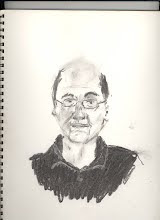I was going through a draw of old poems when I came across this self portrait. I can't remember doing it, I don't believe I ever did anything in this style ever again. I can't remember why I did it.
I can recognise the time of my life it represents: when I worked as a silk-screenprinter in World's End, the bottom rung of Chelsea's King's Road. Another memory of that time survives in the poem I wrote about a colleague who had the misfortune to be schizophrenic.
Holiday season: What is a pudding?
2 years ago









